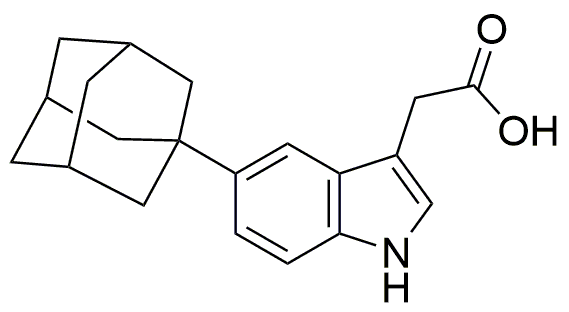5-Adamantyl-IAA is widely utilized in research focused on:
- Plant Growth Regulation: This compound acts as a plant growth regulator, promoting root and shoot development in various plant species, making it valuable in agriculture for enhancing crop yields.
- Pharmaceutical Research: It is explored in drug development for its potential therapeutic effects, particularly in treating conditions related to plant hormones, which can lead to innovative treatments.
- Biochemical Studies: Researchers use this compound to study the mechanisms of action of auxins, a class of plant hormones, helping to unravel complex biological processes.
- Environmental Science: It plays a role in understanding how plants respond to environmental stressors, aiding in the development of more resilient crop varieties.
- Horticulture: This chemical is applied in horticultural practices to optimize flowering and fruiting in ornamental and fruit-bearing plants, enhancing aesthetic and economic value.
General Information
Properties
Safety and Regulations
Applications
5-Adamantyl-IAA is widely utilized in research focused on:
- Plant Growth Regulation: This compound acts as a plant growth regulator, promoting root and shoot development in various plant species, making it valuable in agriculture for enhancing crop yields.
- Pharmaceutical Research: It is explored in drug development for its potential therapeutic effects, particularly in treating conditions related to plant hormones, which can lead to innovative treatments.
- Biochemical Studies: Researchers use this compound to study the mechanisms of action of auxins, a class of plant hormones, helping to unravel complex biological processes.
- Environmental Science: It plays a role in understanding how plants respond to environmental stressors, aiding in the development of more resilient crop varieties.
- Horticulture: This chemical is applied in horticultural practices to optimize flowering and fruiting in ornamental and fruit-bearing plants, enhancing aesthetic and economic value.
Documents
Safety Data Sheets (SDS)
The SDS provides comprehensive safety information on handling, storage, and disposal of the product.
Product Specification (PS)
The PS provides a comprehensive breakdown of the product’s properties, including chemical composition, physical state, purity, and storage requirements. It also details acceptable quality ranges and the product's intended applications.
Certificates of Analysis (COA)
Search for Certificates of Analysis (COA) by entering the products Lot Number. Lot and Batch Numbers can be found on a product’s label following the words ‘Lot’ or ‘Batch’.
Numéro de catalogue
Numéro de lot/série
Certificates Of Origin (COO)
This COO confirms the country where the product was manufactured, and also details the materials and components used in it and whether it is derived from natural, synthetic, or other specific sources. This certificate may be required for customs, trade, and regulatory compliance.
Numéro de catalogue
Numéro de lot/série
Safety Data Sheets (SDS)
The SDS provides comprehensive safety information on handling, storage, and disposal of the product.
DownloadProduct Specification (PS)
The PS provides a comprehensive breakdown of the product’s properties, including chemical composition, physical state, purity, and storage requirements. It also details acceptable quality ranges and the product's intended applications.
DownloadCertificates of Analysis (COA)
Search for Certificates of Analysis (COA) by entering the products Lot Number. Lot and Batch Numbers can be found on a product’s label following the words ‘Lot’ or ‘Batch’.
Numéro de catalogue
Numéro de lot/série
Certificates Of Origin (COO)
This COO confirms the country where the product was manufactured, and also details the materials and components used in it and whether it is derived from natural, synthetic, or other specific sources. This certificate may be required for customs, trade, and regulatory compliance.


